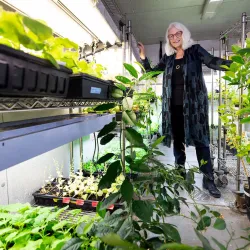Deciphering the Mysteries of Aging
Sometimes scientific breakthroughs happen in the most unexpected ways—like when you are on vacation thousands of miles from your lab. Just ask Assistant Professor of Cell Biology and Molecular Genetics Kan Cao whose research focuses on the premature aging disorder Hutchinson-Gilford Progeria Syndrome (HGPS). Children with HGPS die in their early teens, typically due to heart attack or stroke. The rare disease is caused by a mutation in the gene LMNA.
In 2009, while still a postdoctoral researcher at the National Institutes of Health, Cao headed to China for a three-week break, tasking a student researcher with feeding HGPS cells with the immunosuppressant drug rapamycin. "I figured it would be a good practice exercise," says Cao. After three weeks, the cells began to improve, indicating that the drug might offer effective treatment. Cao continued the research after her CMNS appointment in 2010, publishing a groundbreaking paper on the effect of rapamycin on HGPS cells, and clinical trials are planned for the drug.
While Cao has her eyes on finding a cure for HGPS, her research could have far greater implications. "If we understand why the lamin A protein, produced from LMNA, causes such a drastic disease," says Cao, "it can help us decipher many, many mysteries of aging, including cardiovascular disease."
Cao was the recipient of an Ellison Medical Foundation New Scholar in Aging Award, considered the most important career award in the field of aging.
Watch Cao's talk at Bioscience Day 2012:







